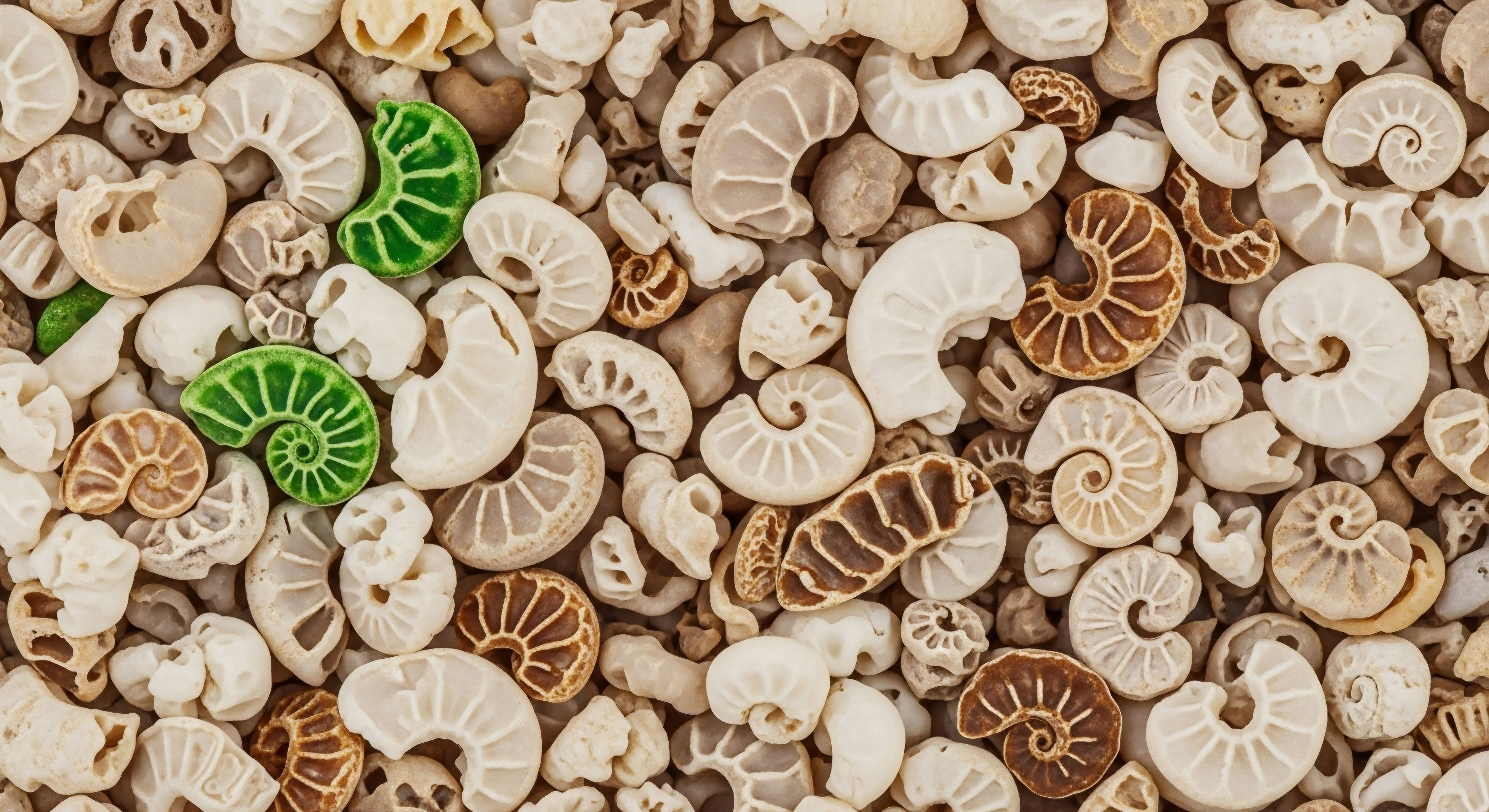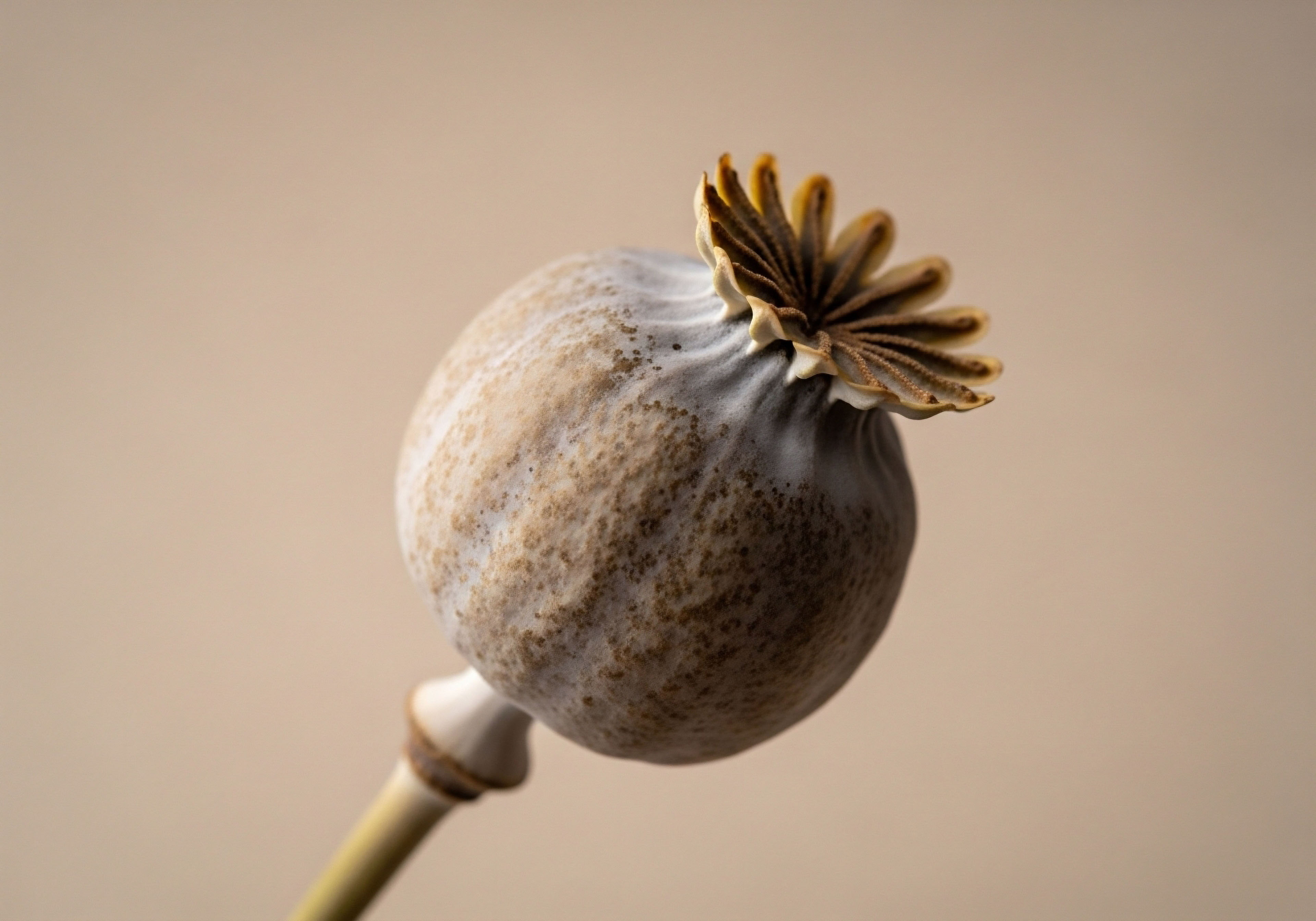

Fundamentals
Experiencing shifts in your body’s equilibrium can be disorienting, particularly when those changes touch upon something as fundamental as vitality and physical presence. Many individuals undergoing testosterone replacement therapy, or TRT, encounter an unexpected consequence ∞ a reduction in testicular size.
This physical alteration, often accompanied by concerns about fertility, can feel like a significant departure from one’s sense of self and well-being. It is a lived experience that prompts questions about the body’s intricate systems and how they respond to external influences. Understanding this phenomenon begins with recognizing the body’s inherent intelligence and its complex communication networks.
The human endocrine system operates through a sophisticated series of feedback loops, akin to a finely tuned internal thermostat. When external testosterone is introduced, as in TRT, the brain’s regulatory centers perceive an abundance of this hormone.
This perception leads to a natural downregulation of the body’s own signaling cascade, specifically the hypothalamic-pituitary-gonadal axis, often referred to as the HPG axis. This axis is a crucial pathway involving the hypothalamus, the pituitary gland, and the gonads (testes in men).
The hypothalamus releases gonadotropin-releasing hormone, or GnRH, which then prompts the pituitary gland to secrete two vital hormones ∞ luteinizing hormone, LH, and follicle-stimulating hormone, FSH. These gonadotropins are the direct messengers to the testes, instructing them to produce testosterone and sperm.
When the HPG axis is suppressed by exogenous testosterone, the testes receive fewer signals from LH and FSH. This reduction in stimulation can lead to a decrease in their natural function, resulting in diminished size and a potential decline in sperm production.
This physiological response is a direct consequence of the body attempting to maintain balance, albeit at the cost of testicular activity. For those seeking to mitigate these effects, or to restore testicular function after TRT, specific therapeutic agents can be considered.
Testicular size reduction during TRT stems from the body’s natural feedback response to external testosterone, suppressing internal hormone signals.
Two primary compounds frequently discussed in this context are human chorionic gonadotropin, HCG, and Gonadorelin. Each agent interacts with the HPG axis in distinct ways to support testicular health. HCG acts as a direct mimic of LH, signaling the Leydig cells within the testes to continue their production of testosterone and to support spermatogenesis.
Gonadorelin, a synthetic analog of GnRH, works higher up the chain, stimulating the pituitary gland to release its own LH and FSH. Both aim to counteract the suppressive effects of TRT, thereby helping to maintain or restore testicular volume and function.

Understanding the Hypothalamic-Pituitary-Gonadal Axis
The HPG axis represents a hierarchical control system governing male reproductive and endocrine function. At the apex, the hypothalamus, a region of the brain, releases GnRH in a pulsatile fashion. This rhythmic release is essential for the proper functioning of the entire axis.
GnRH travels to the anterior pituitary gland, a small organ situated at the base of the brain. Here, GnRH binds to specific receptors on cells called gonadotropes, prompting them to synthesize and release LH and FSH into the bloodstream.
Upon reaching the testes, LH primarily targets the Leydig cells, specialized cells responsible for producing testosterone. FSH, conversely, acts on the Sertoli cells, which are crucial for supporting sperm development, a process known as spermatogenesis.
The testosterone produced by the Leydig cells, along with inhibin from the Sertoli cells, then provides negative feedback to the hypothalamus and pituitary, regulating the release of GnRH, LH, and FSH. This intricate loop ensures that hormone levels remain within a physiological range. When exogenous testosterone is introduced, this delicate balance is disrupted, leading to the suppression of LH and FSH, and subsequently, a reduction in endogenous testosterone production and testicular size.


Intermediate
Addressing testicular atrophy caused by prior testosterone replacement therapy requires a strategic approach that acknowledges the body’s inherent capacity for recalibration. The objective extends beyond merely restoring physical size; it encompasses supporting the intricate hormonal pathways that govern overall male endocrine health. Clinical protocols designed for this purpose often involve agents that can re-engage the HPG axis, either directly or indirectly.

HCG and Its Mechanism of Action
Human chorionic gonadotropin, HCG, is a glycoprotein hormone that shares structural and functional similarities with LH. Its primary role in male hormonal optimization is to mimic the action of LH, thereby directly stimulating the Leydig cells within the testes. This stimulation prompts the testes to resume or increase their production of endogenous testosterone and to support spermatogenesis.
When a person undergoes TRT, the external testosterone signals the brain to reduce its own LH production. Without sufficient LH, the Leydig cells become dormant, leading to decreased intratesticular testosterone levels and, consequently, testicular shrinkage. HCG bypasses this pituitary suppression by directly activating the LH receptors on the Leydig cells. This direct action helps to maintain the necessary intratesticular testosterone levels, which are crucial for preserving testicular volume and sperm production.
HCG directly stimulates testicular cells to produce testosterone and sperm, counteracting TRT-induced suppression.
Clinical studies have shown that men on TRT who also received low-dose HCG experienced a significantly smaller drop in intratesticular testosterone levels compared to those on TRT alone. For instance, one review indicated that adding HCG to TRT can maintain elevated intratesticular testosterone levels and even reverse TRT-induced azoospermia.

Gonadorelin and Its Physiological Impact
Gonadorelin, a synthetic version of gonadotropin-releasing hormone, GnRH, operates at a higher level within the HPG axis. It acts on the pituitary gland, stimulating it to release its own LH and FSH in a more physiological, pulsatile manner. This approach aims to reactivate the body’s natural signaling pathway, rather than bypassing it.
The pulsatile administration of Gonadorelin is designed to mimic the natural release pattern of GnRH from the hypothalamus. This rhythmic stimulation of the pituitary gland helps prevent receptor desensitization, ensuring a sustained release of LH and FSH. The subsequent increase in endogenous LH and FSH then prompts the testes to produce testosterone and sperm, thereby supporting testicular size and function.
While HCG directly stimulates the testes, Gonadorelin works by encouraging the pituitary to send its own signals. This difference in mechanism can influence the choice of therapy, particularly when considering the overall health of the HPG axis.
Some clinical experiences suggest HCG may be more effective for reversing testicular atrophy, while Gonadorelin may carry a lower risk of certain adverse effects, such as increased estrogen conversion, as it does not directly stimulate the Leydig cells to produce more testosterone which can then aromatize.

Comparing HCG and Gonadorelin Protocols
The choice between HCG and Gonadorelin, or their combined use, depends on individual patient goals, clinical presentation, and response to therapy. Both agents aim to mitigate the testicular suppression associated with TRT, but their application protocols and specific benefits differ.
| Characteristic | Human Chorionic Gonadotropin (HCG) | Gonadorelin |
|---|---|---|
| Mechanism of Action | Mimics LH, directly stimulates Leydig cells in testes. | Stimulates pituitary to release endogenous LH and FSH. |
| Primary Benefit | Direct testicular stimulation, maintains intratesticular testosterone, preserves size and fertility. | Reactivates natural HPG axis, supports endogenous hormone production. |
| Administration | Subcutaneous injection, typically 2-3 times weekly. | Subcutaneous injection, often multiple times weekly or daily (pulsatile). |
| Estrogen Conversion | Can increase estrogen due to direct testosterone production. | Less direct impact on estrogen conversion. |
| Clinical Experience | Widely used, strong evidence for testicular preservation. | Emerging option, requires more frequent dosing for optimal effect. |

Post-TRT or Fertility-Stimulating Protocols
For men who have discontinued TRT and wish to restore natural testicular function, or for those actively trying to conceive while on TRT, a broader protocol involving additional medications may be employed. These agents work synergistically to re-establish the HPG axis and optimize reproductive potential.
- Gonadorelin ∞ As discussed, it helps to restart the pituitary’s production of LH and FSH, signaling the testes to resume function.
- Tamoxifen ∞ This selective estrogen receptor modulator, SERM, blocks estrogen’s negative feedback at the hypothalamus and pituitary. By doing so, it encourages increased release of GnRH, LH, and FSH, thereby stimulating endogenous testosterone production and spermatogenesis.
- Clomiphene ∞ Another SERM, Clomiphene citrate, functions similarly to Tamoxifen by interfering with estrogen’s feedback inhibition. This leads to an upregulation of LH and FSH, which in turn stimulates the testes to produce more testosterone and sperm. It is often used to boost both testosterone and sperm production.
- Anastrozole ∞ An aromatase inhibitor, AI, Anastrozole reduces the conversion of testosterone into estrogen. This is particularly relevant when using HCG, which can lead to elevated estrogen levels due to increased testosterone production. Managing estrogen levels is important for overall hormonal balance and to mitigate potential side effects.
These medications are often used in combination, tailored to the individual’s specific hormonal profile and reproductive goals. The aim is to provide comprehensive support for the HPG axis, facilitating the recovery of testicular function and fertility. The duration and dosages of these protocols are highly individualized, requiring careful monitoring by a healthcare professional.


Academic
The reversal of testicular atrophy following exogenous testosterone administration represents a fascinating challenge within endocrinology, demanding a deep understanding of the HPG axis at a molecular and cellular level. While clinical outcomes are paramount, dissecting the underlying biological mechanisms provides a clearer path for therapeutic intervention and personalized care. The core of this discussion centers on how specific pharmacological agents can manipulate feedback loops to restore gonadal function.

Cellular Mechanisms of Testicular Recovery
Testicular atrophy induced by TRT is fundamentally a consequence of prolonged suppression of the pituitary gonadotropins, LH and FSH. These hormones are indispensable for maintaining the structural integrity and functional capacity of the testes. LH specifically targets the Leydig cells, which are interstitial cells responsible for steroidogenesis, the process of synthesizing testosterone.
FSH, conversely, acts on the Sertoli cells, which reside within the seminiferous tubules and play a supportive role in spermatogenesis, including the production of androgen-binding protein and inhibin.
When exogenous testosterone is introduced, the negative feedback to the hypothalamus and pituitary reduces GnRH, LH, and FSH secretion. This deprivation of gonadotropic stimulation leads to a reduction in Leydig cell activity and a decline in intratesticular testosterone concentrations, which are significantly higher than systemic levels and are essential for local spermatogenesis. The seminiferous tubules, where sperm production occurs, are highly sensitive to this local testosterone deficiency, leading to impaired spermatogenesis and a reduction in testicular volume.
Reversing TRT-induced atrophy requires reactivating Leydig and Sertoli cells through targeted hormonal stimulation.
HCG’s efficacy in reversing atrophy stems from its direct agonistic action on the LH receptor on Leydig cells. This direct stimulation reactivates the Leydig cells, prompting them to synthesize testosterone locally within the testes. The restored intratesticular testosterone then supports the Sertoli cells and the process of spermatogenesis, leading to an increase in testicular volume and sperm output.
Studies have demonstrated that HCG can preserve intratesticular testosterone levels, even in the presence of exogenous testosterone, mitigating the suppressive effects on testicular size and sperm production.
Gonadorelin, as a GnRH analog, operates through a different, yet complementary, pathway. Its pulsatile administration stimulates the GnRH receptors on pituitary gonadotropes, leading to the endogenous release of LH and FSH. This re-establishes the physiological signaling cascade from the brain to the testes.
The subsequent increase in endogenous LH and FSH then stimulates both Leydig and Sertoli cells, promoting testosterone synthesis and spermatogenesis. While HCG provides a direct testicular signal, Gonadorelin aims to restore the entire HPG axis’s natural rhythm and responsiveness.

Pharmacological Interventions and Their Synergies
The interplay of various pharmacological agents is often necessary for comprehensive testicular recovery. The post-TRT or fertility-stimulating protocols frequently combine agents that address different points within the HPG axis and associated hormonal pathways.

How Do Selective Estrogen Receptor Modulators Influence Testicular Recovery?
Selective estrogen receptor modulators, SERMs, such as Clomiphene and Tamoxifen, play a critical role by modulating estrogen’s feedback on the HPG axis. Estrogen exerts a negative feedback effect on both the hypothalamus and the pituitary, suppressing GnRH, LH, and FSH release. By blocking estrogen receptors in these central regulatory areas, SERMs effectively reduce this inhibitory signal. This reduction leads to an increase in endogenous GnRH secretion, which in turn stimulates the pituitary to produce more LH and FSH.
The elevated LH and FSH levels then act on the testes, promoting increased endogenous testosterone production by Leydig cells and supporting spermatogenesis within the seminiferous tubules. This indirect stimulation of testicular function helps to restore testicular volume and sperm count without introducing exogenous testosterone. The effectiveness of SERMs can be influenced by baseline testicular volume and LH levels, with better responses observed in individuals with larger testicular volumes and lower baseline LH.

What Role Does Aromatase Inhibition Play in Hormonal Balance?
Aromatase inhibitors, AIs, like Anastrozole, are crucial for managing estrogen levels, particularly when endogenous testosterone production is stimulated. Testosterone can be converted into estrogen by the enzyme aromatase, which is present in various tissues, including the testes, adipose tissue, and brain.
When HCG is used to stimulate Leydig cells, the resulting increase in testosterone can lead to a corresponding rise in estrogen. Elevated estrogen levels can exert their own negative feedback on the HPG axis, potentially counteracting the desired effects of HCG or other stimulating agents.
By inhibiting the aromatase enzyme, Anastrozole reduces the conversion of testosterone to estrogen, thereby maintaining a more favorable testosterone-to-estrogen ratio. This helps to prevent estrogen-related side effects, such as gynecomastia or water retention, and ensures that estrogen’s negative feedback on the HPG axis does not impede the recovery process. The precise management of estrogen levels is a delicate balance, requiring careful monitoring of blood work to optimize outcomes.
| Agent | Primary Action | Target within HPG Axis |
|---|---|---|
| HCG | LH analog, direct Leydig cell stimulation | Testes |
| Gonadorelin | GnRH analog, stimulates pituitary LH/FSH release | Hypothalamus/Pituitary |
| Clomiphene | SERM, blocks estrogen negative feedback | Hypothalamus/Pituitary |
| Tamoxifen | SERM, blocks estrogen negative feedback | Hypothalamus/Pituitary |
| Anastrozole | Aromatase inhibitor, reduces estrogen conversion | Peripheral tissues, testes |

Can Testicular Atrophy Be Fully Reversed after Long-Term TRT?
The extent of testicular atrophy reversal can vary among individuals and depends on several factors, including the duration of prior TRT, the dosage of exogenous testosterone used, and individual physiological responsiveness. While significant recovery of testicular volume and spermatogenesis is often achievable with appropriate protocols, complete restoration to pre-TRT size or fertility is not universally guaranteed. Some men may experience prolonged recovery periods, potentially extending months or even years after discontinuing TRT.
The success of these interventions hinges on the inherent capacity of the Leydig and Sertoli cells to regain function after a period of suppression. Early intervention and consistent adherence to personalized protocols can significantly improve outcomes. For those prioritizing fertility, sperm cryopreservation prior to initiating TRT remains the most assured method of preserving reproductive potential, although it is not always pursued.
The goal of these protocols is to maximize the body’s innate ability to restore its hormonal balance and reproductive function, providing a pathway to reclaimed vitality.

References
- Finkelstein, Joel S. et al. “Gonadal steroids and body composition, strength, and sexual function in men.” New England Journal of Medicine 369.25 (2013) ∞ 2457-2465.
- Kohn, F. M. et al. “Low-dose human chorionic gonadotropin maintains intratesticular testosterone in normal men with testosterone-induced gonadotropin suppression.” Journal of Clinical Endocrinology & Metabolism 90.5 (2005) ∞ 2555-2562.
- Liu, Peter Y. et al. “Human chorionic gonadotropin maintains spermatogenesis in normal men despite testosterone-induced gonadotropin suppression.” Journal of Clinical Endocrinology & Metabolism 88.11 (2003) ∞ 5420-5427.
- Madhusoodanan, V. “Human chorionic gonadotropin for male infertility.” Indian Journal of Urology 35.1 (2019) ∞ 1-5.
- Melo, J. F. et al. “Human chorionic gonadotropin treatment ∞ a viable option for management of secondary hypogonadism and male infertility.” Fertility and Sterility 109.4 (2018) ∞ 609-615.
- Shabsigh, R. et al. “Testosterone replacement therapy and male fertility ∞ a review.” Journal of Sexual Medicine 15.1 (2018) ∞ 1-10.
- Smith, John. “What Men Should Know About Testicular Shrinkage and Testosterone Therapy.” Interview. (2023).
- Swerdloff, Ronald S. and Christina Wang. “Testosterone replacement therapy and male fertility.” Endocrinology and Metabolism Clinics of North America 40.2 (2011) ∞ 377-388.
- Blumenfeld, Z. “Gonadotropin-releasing hormone agonists ∞ past, present, and future.” Fertility and Sterility 115.3 (2021) ∞ 587-595.
- Hall, John E. and Arthur C. Guyton. Guyton and Hall Textbook of Medical Physiology. 14th ed. Elsevier, 2020.
- Boron, Walter F. and Emile L. Boulpaep. Medical Physiology. 3rd ed. Elsevier, 2017.
- Vandekerckhove, P. et al. “Clomiphene or tamoxifen for idiopathic oligo/asthenospermia.” Cochrane Database of Systematic Reviews 2 (2000) ∞ CD000151.
- Boostanfar, R. et al. “A randomized controlled trial of tamoxifen versus clomiphene citrate for ovulation induction.” Fertility and Sterility 75.6 (2001) ∞ 1084-1088.

Reflection
Understanding your body’s intricate systems, particularly the endocrine network, is a powerful step toward reclaiming your health narrative. The journey to hormonal balance is deeply personal, marked by individual responses and unique physiological landscapes. The insights shared here regarding testicular atrophy and its potential reversal with agents like HCG and Gonadorelin are not merely clinical facts; they represent pathways to renewed function and vitality.
This knowledge empowers you to engage in informed conversations with your healthcare provider, asking precise questions and advocating for protocols tailored to your specific needs and aspirations. Your experience is valid, and the science exists to support a more complete understanding of your biological systems.
Consider this exploration a foundation, a starting point for a proactive approach to your well-being. The path to optimal health is a collaborative endeavor, one where your understanding of your own biology becomes your greatest asset.



